Unit7 Films课件(共31张PPT) 牛津译林版九年级英语上册
文档属性
| 名称 | Unit7 Films课件(共31张PPT) 牛津译林版九年级英语上册 | 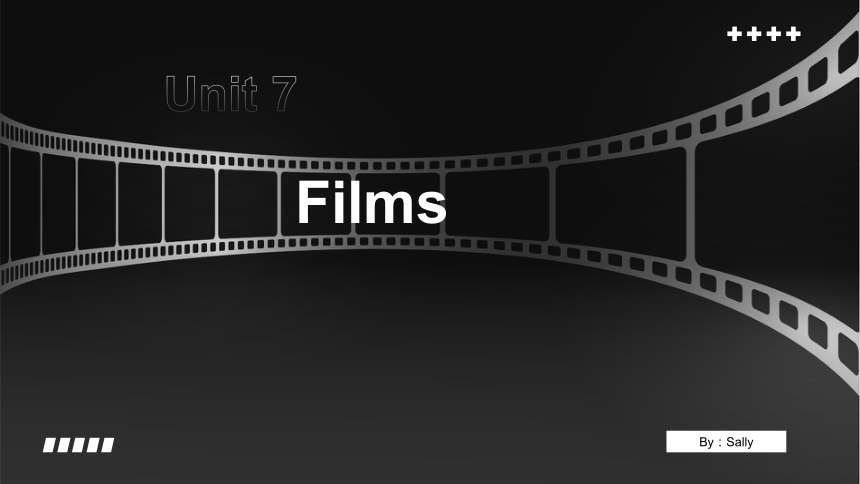 | |
| 格式 | pptx | ||
| 文件大小 | 4.4MB | ||
| 资源类型 | 教案 | ||
| 版本资源 | 牛津译林版 | ||
| 科目 | 英语 | ||
| 更新时间 | 2025-02-03 08:47:27 | ||
图片预览


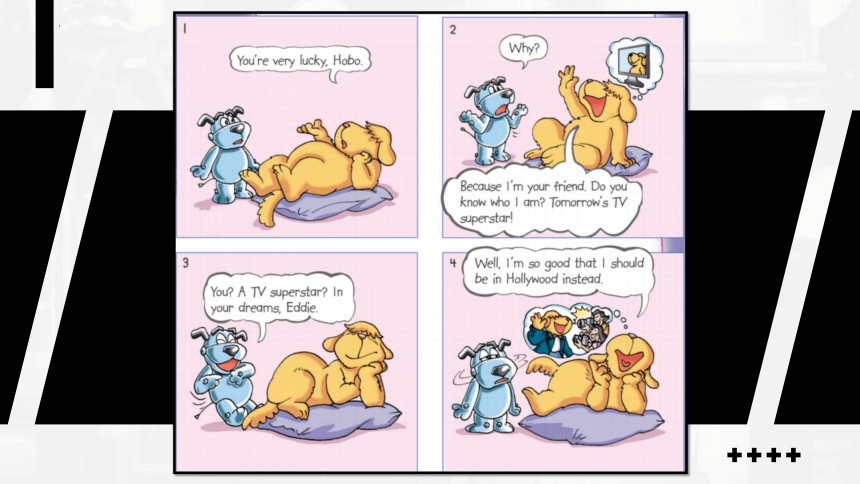
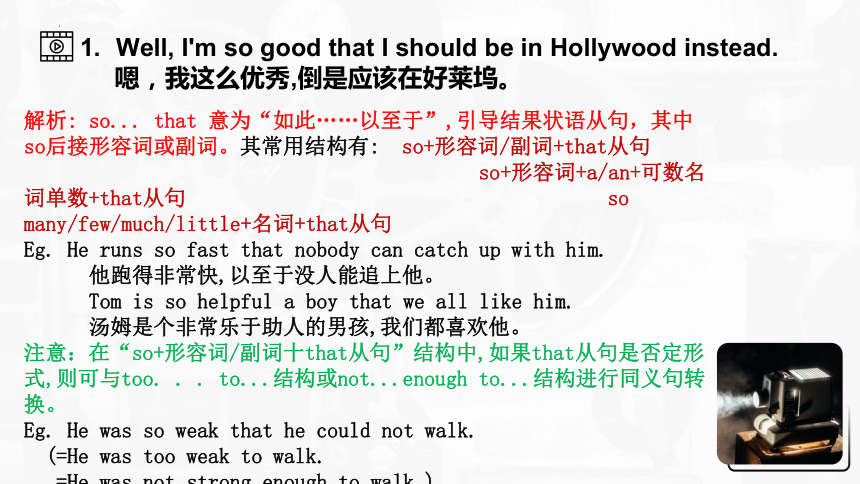
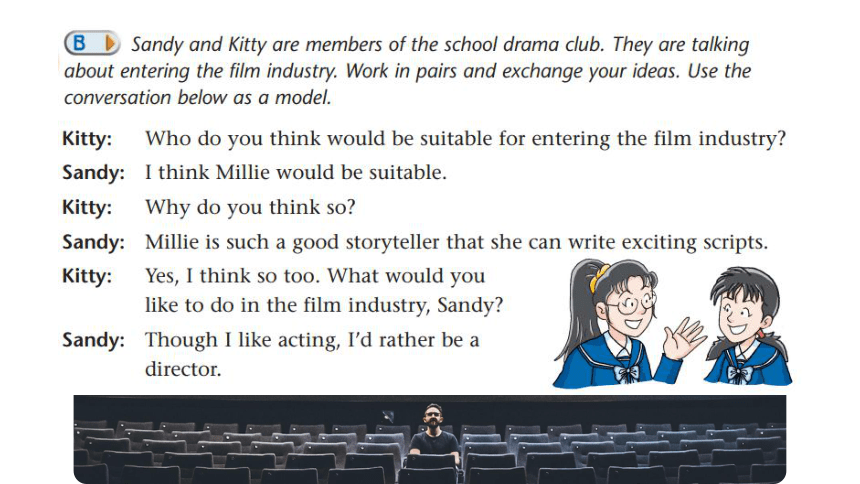



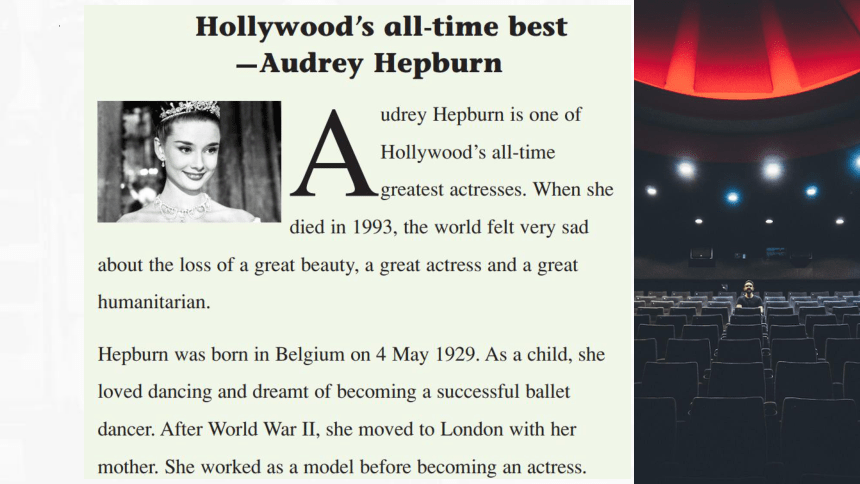
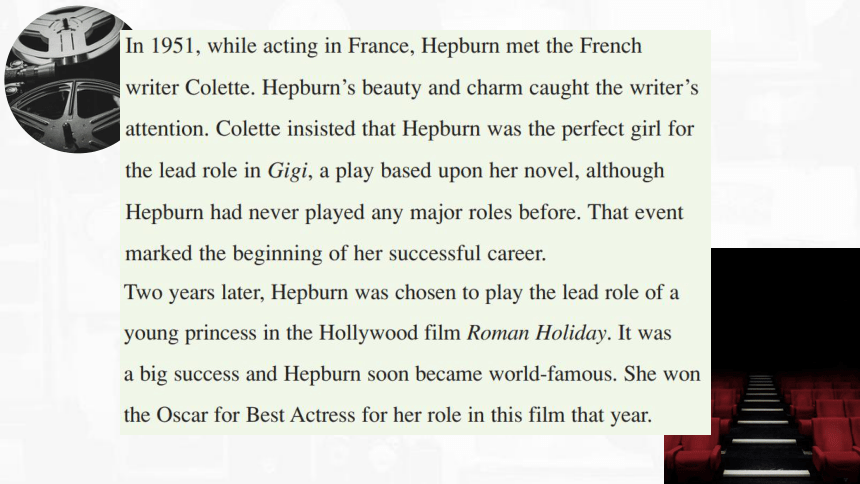
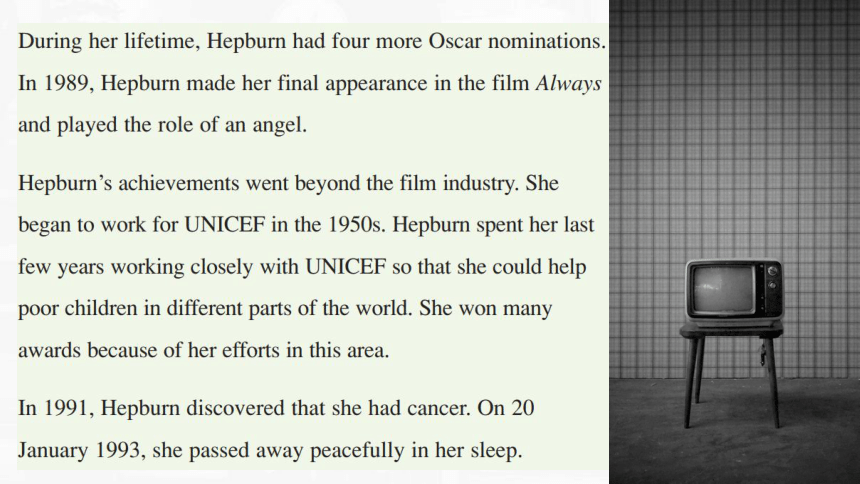
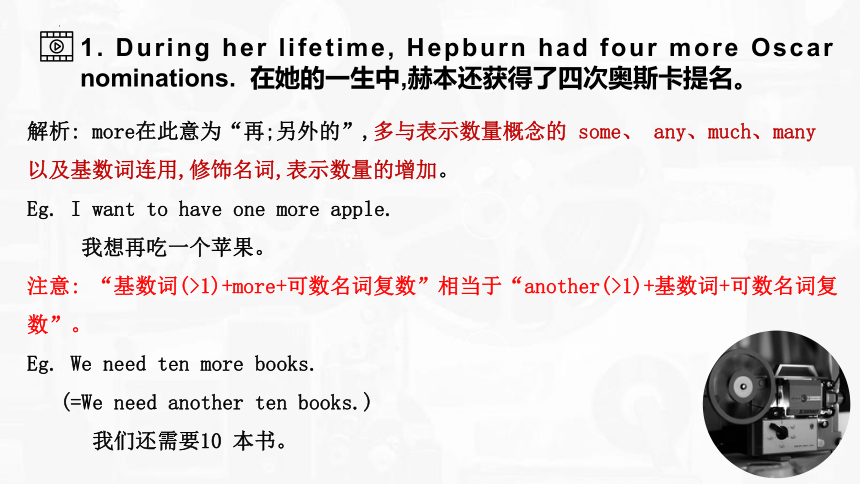
文档简介
(共31张PPT)
Films
By:Sally
Unit 7
Welcome to the unit
PART 01
行业PPT模板http:///hangye/
Well, I'm so good that I should be in Hollywood instead.
嗯,我这么优秀,倒是应该在好莱坞。
解析: so... that 意为“如此……以至于”,引导结果状语从句,其中 so后接形容词或副词。其常用结构有: so+形容词/副词+that从句
so+形容词+a/an+可数名词单数+that从句 so many/few/much/little+名词+that从句
Eg. He runs so fast that nobody can catch up with him.
他跑得非常快,以至于没人能追上他。
Tom is so helpful a boy that we all like him.
汤姆是个非常乐于助人的男孩,我们都喜欢他。
注意:在“so+形容词/副词十that从句”结构中,如果that从句是否定形式,则可与too. . . to...结构或not...enough to...结构进行同义句转换。
Eg. He was so weak that he could not walk.
(=He was too weak to walk.
=He was not strong enough to walk.)
他太虚弱了,以至于走不动路。
2. Who do you think would be suitable for entering the film industry 你认为谁适合进入电影业
结构分析:本句是一个简单句,其结构为“疑问词(主语)+do you think+谓语+其他 ”
do you think是插入语,常置于疑问词之后。
Eg. Which city do you think is more beautiful, Nantong or Shanghai
你认为哪个城市更漂亮,南通还是上海
拓展:①若疑问词本身不是主语,则用“疑问词+do you think+主语+谓语+其他 ”结构。
Eg. What do you think I should do
你认为我应该做什么
②插人语通常与句中其他部分没有语法上的联系,删掉之后句子结构仍然完整。
3. Millie is such a good storyteller that she can write exciting scripts.
米莉是一个如此好的讲故事的人,以至于她可以写出激动人心的剧本。
解析: such...that 意为“如此……以至于”,such 后面接名词,名词前可以有形容词等修饰,
其常用结构有: such+ a/an+形容词+可数名词单数+that从句
such+形容词+可数名词复数+that从句
such+形容词+不可数名词+that从句
Eg. It's such an important match that we can't miss it.
这是如此重要的一场比赛,我们不能错过。
This is such hard work that few people can finish it on time.
这项工作如此困难,很少有人能按时完成。
注意: such...that 结构有时可与so...that结构进行同义句转换。
Eg. It's such a heavy stone that we can't move it.
(=The stone is so heavy that we can't move it.)
这块石头太重了,以至于我们搬不动它。
Reading
PART 02
1. During her lifetime, Hepburn had four more Oscar nominations. 在她的一生中,赫本还获得了四次奥斯卡提名。
解析: more在此意为“再;另外的”,多与表示数量概念的 some、 any、much、many 以及基数词连用,修饰名词,表示数量的增加。
Eg. I want to have one more apple.
我想再吃一个苹果。
注意: “基数词(>1)+more+可数名词复数”相当于“another(>1)+基数词+可数名词复数”。
Eg. We need ten more books.
(=We need another ten books.)
我们还需要10 本书。
2. She began to work for UNICEF in the 1950s.
在20世纪50年9代,她开始为联合国儿童基金会工作。
解析: in the 1950s 意为“在20世纪50年代”,也可写作 in the 1950’s。
eg. in the 1960s/1960’s 在20世纪60年代
归纳: 年份、年代、日期的读写和年、月、日的表达法:
年份、年代、时期的读写:
1985: nineteen eighty-five; 2000: two thousand;
1990's: nineteen nineties; 在80年代: in the eighties;
在某人五十几岁时: in one's fifties
年、月、日的表达法:
1949年5月1日: May (the) first , nineteen forty- nine
或 the first of May , nineteen forty-nine。
Grammar
PART 03
让步状语从句
让步状语从句表示即使出现从句中的情况,主句动作仍然会发生,有“退一步说……”的意思。让步状语从句常由although/though引导,意为“虽然,尽管”。
although和 though的用法基本相同,一般情况下可以互换使用;前者比后者更正式一些,在口语中常用 though。另外 although 语气较though 重。
Eg. Although/Though his mother is almost 40, she still plans to compete.
尽管他妈妈快40岁了,她仍然打算竞争。
Although/Though engineer seems like a good job, I would prefer to be a teacher.
尽管工程师看起来是个不错的工作,但我还是想成为一名老师。
注意: 在英语中,although/though 和but不能同时使用,但可以和 yet 或 still 连用。
Although he tried hard, but he failed. ( X )
Although he tried hard, he still failed. (√)
尽管他很努力,他还是失败了。
He tried hard, but he failed.(√)
他很努力,但失败了。
结果状语从句
结果状语从句用来补充说明主句动作发生所带来的结果。引导这一从句常用so... that, such...that 等。
引导词 用法 常见结构 例句
so... that 意为“如此……以至于”。so 为副词,表示程度,可修饰形容词或副词。 so +形容词/副词+that 从句 The scientist's report was so instructive that we were all very excited.
这位科学家的报告很有启发性,我们都感到很兴奋。
so+形容词+a/ an+可数名词单数+that从句 Mike is so honest a man that we all believe him.
迈克是一个非常诚实的人,我们都相信他。
so+ many/much/ few/little+名词+that从句 He made so many mistakes that he failed the exam again.
他出了如此多的错以至于考试又没及格。
引导词 用法 常见结构 例句
such... that 含义与 so... that相同。但 such是形容词,只能修可数名词或名词词组。 such + a/an+形容词+可数名词单数+that从句 It was such a terrible day that we had to stay at home.
天气太糟糕了,我们只能待在家里。
such+形容词+ 可数名词复数+that从句 They are such lovely children that we all like them.
这些孩子如此可爱,我们都很喜欢他们。
such+形容词+不可数名词+that从句 It was such fine music that I listened to it twice.
这音乐太好听了,我听了两遍。
注意:①“such +a/an+形容词+可数名词单数+that 从句” 可与 “so+形容词+a/an+可数名词单数十that从句”互换,但使用时一定要注意不定冠词的位置。
Eg. It's such a small kitchen that I don't have to do much to keep it clean.
(=It's so small a kitchen that I don't have to do much to keep it clean. )
厨房这么小,我不必做太多就能让它保持清洁。
注意:②当that前的名词被表示数量多少的many、much、few、little(少)等词修饰时,只能用so,不能用such;除此处,当that前是不可数名词或可数名词复数时,则必须用such,不能用so。
Eg. There was so much noise outside that we couldn't hear the teacher.
外面嘈杂声如此大,以至于我们听不到老师的话。
They are such nice apples that we would like to eat them.
它们是如此好的苹果,以至于我们想吃。
③so.. .that 和 such... that结构可以和too.. . to 或“形容词/副词+enough to”句型互换。若that引导的从句是否定句,通常用too. . .to;若that 引导的从句是肯定句,通常用“形容词/副词+enough to”。
Eg. The box is so heavy that he can't carry it.
(=The box is too heavy for him to carry.)
这箱子是如此重,以至于他搬不动。
The boy is so clever that he can work out the problem.
(=The boy is clever enough to work out the problem. )
这个男孩如此聪明,以至于可以解出这道题。
目的状语从句
目的状语从句用于说明主句动作发生的目的,常由 so that/in order that 来引导,意为“为了,以便”。在目的状语从句中,多使用假定性的谓语动词,即谓语中含有can、could、 may、might、will、would 和should 等情态动词。主从句连接紧凑,没有逗号相隔。
Eg. Speak louder so that/in order that everyone can hear you.
大点儿声讲,好让每个人都能听见。
They set out very early so that /in order that they would arrive in time.
他们很早就动身了,以便能及时到达。
Skills & Task
PART 04
a woman falls in love with a man when she travels(15)__...
一个女人在(15)__旅行时爱上了一个男人……
解析: fall in love with sb./sth.意为“爱上某人/喜欢上某事物”, fall是非延续性动词,表示动作。
Eg. I fell in love with Shanghai when I visited the city for the first time.
我第一次到上海就喜欢上了这座城市。
联想: be in love with sb./sth.意为“与某人相爱/喜欢某事物”,表示状态。
Eg. They have been in love with each other for five years.
他们相爱已经五年了。
拓展: 非延续性动词表示不能延续的动作,可用于完成时,但不能与表示一段时间的状语连用。若要与表示一段时间的状语连用,通常用意义相同的延续性动词替换。
意义相同的非延续性动词和延续性动词的对应如下:
非延续性动词 begin/ start come back leave buy borrow die
延续性动词 be on be back be away from have keep be dead
2. Neither do l.我也不喜欢。
解析: neither do I意为“我也不……”,相当于me neither.
“neither +be 动词/助动词/情态动词十主语”结构,表示前者的否定情况也适用于后者。
Eg. ---I don't like this dress. 我不喜欢这条连衣裙。
---Neither do I.(=Me neither.) 我也不喜欢。
---Tom can't play the piano at all. 汤姆根本不会弹钢琴。
---Neither can Mary. 玛丽也不会。
联想: ①“so+be 动词/助动词/情态动词+主语”结构,表示前者的肯定情况也适于后者,意为“……也是如此”。
Eg. I feel very happy. So does he.
我感到很高兴。他也是。
②“so+主语+be动词/助动词/情态动词”意为“确实如此”,该结构表示对前面所述情况做进一步肯定,前后两个句子的主语相同。
Eg. ---Tom works very hard. 汤姆工作很努力。
---So he does. 的确如此。
2. Neither do l.我也不喜欢。
neither 作副词,意为“也不”。常用于“neither+be 动词/助动词/情态动词+主语”结构,表示前者的否定情况也适用于后者。
作代词,意为“两者都不”。作主语时,谓语动词通常用第三人称单数形式。
作限定词,意为“两者都不”,常置于可数名词单数前。其反义词为 both。neither与可数名词单数连用作主语时,谓语动词用第三人称单数形式。
作连词,意为“(否定句中)两者之一不”。常用于 neither...nor...“既不……也不……”结构。
3. They seem to be full of mysteries, but in fact, they're quite stupid. 它们好像充满神秘,但事实上,它们很愚蠢。
解析: quite程度副词,意为“相当;十分”,可修饰动词、形容词和副词等。
Eg. I quite agree with you.
我非常赞同你的看法。
His hair is quite thin on top now.
他头顶的头发现在很稀疏了。
Amy is at college, and she's doing quite well.
埃米在上大学,她成绩很不错。
联想: ① quite、very二者均为副词,意为“很;非常;十分”,但与形容词连用修饰名词时,它们的位置不同:quite常放在冠词之前,very 则用于冠词之后。
Eg. It's quite a long way.(=It's a very long way.)
那是一段很长的路。
② quite 可修饰动词,而very 却不能。
4. Miss Prism is seated at the table. 普利兹姆女士坐在桌子旁。
解析: seat 在此作及物动词,意为“安排(某人)就座”,不用于进行时,常与反身代词连用,或用于be seated 这一形式。
Eg. She seated herself at her desk.
她坐在自己的书桌旁。
Please be seated.(=Please sit down.)
请就座。
搭配: seat sb. +介词短语 安排某人就座……
seat oneself+介词短语 使自己就座……
Eg. He seated himself behind his brother.
他在他哥哥后面坐下。
I was seated at the window by my mother.
我被我妈妈安排坐在窗边。
拓展: seat 还可作可数名词,意为“座椅;座位”。
其常见搭配为 have/take a seat“坐下”。
Thank you!
Films
By:Sally
Unit 7
Welcome to the unit
PART 01
行业PPT模板http:///hangye/
Well, I'm so good that I should be in Hollywood instead.
嗯,我这么优秀,倒是应该在好莱坞。
解析: so... that 意为“如此……以至于”,引导结果状语从句,其中 so后接形容词或副词。其常用结构有: so+形容词/副词+that从句
so+形容词+a/an+可数名词单数+that从句 so many/few/much/little+名词+that从句
Eg. He runs so fast that nobody can catch up with him.
他跑得非常快,以至于没人能追上他。
Tom is so helpful a boy that we all like him.
汤姆是个非常乐于助人的男孩,我们都喜欢他。
注意:在“so+形容词/副词十that从句”结构中,如果that从句是否定形式,则可与too. . . to...结构或not...enough to...结构进行同义句转换。
Eg. He was so weak that he could not walk.
(=He was too weak to walk.
=He was not strong enough to walk.)
他太虚弱了,以至于走不动路。
2. Who do you think would be suitable for entering the film industry 你认为谁适合进入电影业
结构分析:本句是一个简单句,其结构为“疑问词(主语)+do you think+谓语+其他 ”
do you think是插入语,常置于疑问词之后。
Eg. Which city do you think is more beautiful, Nantong or Shanghai
你认为哪个城市更漂亮,南通还是上海
拓展:①若疑问词本身不是主语,则用“疑问词+do you think+主语+谓语+其他 ”结构。
Eg. What do you think I should do
你认为我应该做什么
②插人语通常与句中其他部分没有语法上的联系,删掉之后句子结构仍然完整。
3. Millie is such a good storyteller that she can write exciting scripts.
米莉是一个如此好的讲故事的人,以至于她可以写出激动人心的剧本。
解析: such...that 意为“如此……以至于”,such 后面接名词,名词前可以有形容词等修饰,
其常用结构有: such+ a/an+形容词+可数名词单数+that从句
such+形容词+可数名词复数+that从句
such+形容词+不可数名词+that从句
Eg. It's such an important match that we can't miss it.
这是如此重要的一场比赛,我们不能错过。
This is such hard work that few people can finish it on time.
这项工作如此困难,很少有人能按时完成。
注意: such...that 结构有时可与so...that结构进行同义句转换。
Eg. It's such a heavy stone that we can't move it.
(=The stone is so heavy that we can't move it.)
这块石头太重了,以至于我们搬不动它。
Reading
PART 02
1. During her lifetime, Hepburn had four more Oscar nominations. 在她的一生中,赫本还获得了四次奥斯卡提名。
解析: more在此意为“再;另外的”,多与表示数量概念的 some、 any、much、many 以及基数词连用,修饰名词,表示数量的增加。
Eg. I want to have one more apple.
我想再吃一个苹果。
注意: “基数词(>1)+more+可数名词复数”相当于“another(>1)+基数词+可数名词复数”。
Eg. We need ten more books.
(=We need another ten books.)
我们还需要10 本书。
2. She began to work for UNICEF in the 1950s.
在20世纪50年9代,她开始为联合国儿童基金会工作。
解析: in the 1950s 意为“在20世纪50年代”,也可写作 in the 1950’s。
eg. in the 1960s/1960’s 在20世纪60年代
归纳: 年份、年代、日期的读写和年、月、日的表达法:
年份、年代、时期的读写:
1985: nineteen eighty-five; 2000: two thousand;
1990's: nineteen nineties; 在80年代: in the eighties;
在某人五十几岁时: in one's fifties
年、月、日的表达法:
1949年5月1日: May (the) first , nineteen forty- nine
或 the first of May , nineteen forty-nine。
Grammar
PART 03
让步状语从句
让步状语从句表示即使出现从句中的情况,主句动作仍然会发生,有“退一步说……”的意思。让步状语从句常由although/though引导,意为“虽然,尽管”。
although和 though的用法基本相同,一般情况下可以互换使用;前者比后者更正式一些,在口语中常用 though。另外 although 语气较though 重。
Eg. Although/Though his mother is almost 40, she still plans to compete.
尽管他妈妈快40岁了,她仍然打算竞争。
Although/Though engineer seems like a good job, I would prefer to be a teacher.
尽管工程师看起来是个不错的工作,但我还是想成为一名老师。
注意: 在英语中,although/though 和but不能同时使用,但可以和 yet 或 still 连用。
Although he tried hard, but he failed. ( X )
Although he tried hard, he still failed. (√)
尽管他很努力,他还是失败了。
He tried hard, but he failed.(√)
他很努力,但失败了。
结果状语从句
结果状语从句用来补充说明主句动作发生所带来的结果。引导这一从句常用so... that, such...that 等。
引导词 用法 常见结构 例句
so... that 意为“如此……以至于”。so 为副词,表示程度,可修饰形容词或副词。 so +形容词/副词+that 从句 The scientist's report was so instructive that we were all very excited.
这位科学家的报告很有启发性,我们都感到很兴奋。
so+形容词+a/ an+可数名词单数+that从句 Mike is so honest a man that we all believe him.
迈克是一个非常诚实的人,我们都相信他。
so+ many/much/ few/little+名词+that从句 He made so many mistakes that he failed the exam again.
他出了如此多的错以至于考试又没及格。
引导词 用法 常见结构 例句
such... that 含义与 so... that相同。但 such是形容词,只能修可数名词或名词词组。 such + a/an+形容词+可数名词单数+that从句 It was such a terrible day that we had to stay at home.
天气太糟糕了,我们只能待在家里。
such+形容词+ 可数名词复数+that从句 They are such lovely children that we all like them.
这些孩子如此可爱,我们都很喜欢他们。
such+形容词+不可数名词+that从句 It was such fine music that I listened to it twice.
这音乐太好听了,我听了两遍。
注意:①“such +a/an+形容词+可数名词单数+that 从句” 可与 “so+形容词+a/an+可数名词单数十that从句”互换,但使用时一定要注意不定冠词的位置。
Eg. It's such a small kitchen that I don't have to do much to keep it clean.
(=It's so small a kitchen that I don't have to do much to keep it clean. )
厨房这么小,我不必做太多就能让它保持清洁。
注意:②当that前的名词被表示数量多少的many、much、few、little(少)等词修饰时,只能用so,不能用such;除此处,当that前是不可数名词或可数名词复数时,则必须用such,不能用so。
Eg. There was so much noise outside that we couldn't hear the teacher.
外面嘈杂声如此大,以至于我们听不到老师的话。
They are such nice apples that we would like to eat them.
它们是如此好的苹果,以至于我们想吃。
③so.. .that 和 such... that结构可以和too.. . to 或“形容词/副词+enough to”句型互换。若that引导的从句是否定句,通常用too. . .to;若that 引导的从句是肯定句,通常用“形容词/副词+enough to”。
Eg. The box is so heavy that he can't carry it.
(=The box is too heavy for him to carry.)
这箱子是如此重,以至于他搬不动。
The boy is so clever that he can work out the problem.
(=The boy is clever enough to work out the problem. )
这个男孩如此聪明,以至于可以解出这道题。
目的状语从句
目的状语从句用于说明主句动作发生的目的,常由 so that/in order that 来引导,意为“为了,以便”。在目的状语从句中,多使用假定性的谓语动词,即谓语中含有can、could、 may、might、will、would 和should 等情态动词。主从句连接紧凑,没有逗号相隔。
Eg. Speak louder so that/in order that everyone can hear you.
大点儿声讲,好让每个人都能听见。
They set out very early so that /in order that they would arrive in time.
他们很早就动身了,以便能及时到达。
Skills & Task
PART 04
a woman falls in love with a man when she travels(15)__...
一个女人在(15)__旅行时爱上了一个男人……
解析: fall in love with sb./sth.意为“爱上某人/喜欢上某事物”, fall是非延续性动词,表示动作。
Eg. I fell in love with Shanghai when I visited the city for the first time.
我第一次到上海就喜欢上了这座城市。
联想: be in love with sb./sth.意为“与某人相爱/喜欢某事物”,表示状态。
Eg. They have been in love with each other for five years.
他们相爱已经五年了。
拓展: 非延续性动词表示不能延续的动作,可用于完成时,但不能与表示一段时间的状语连用。若要与表示一段时间的状语连用,通常用意义相同的延续性动词替换。
意义相同的非延续性动词和延续性动词的对应如下:
非延续性动词 begin/ start come back leave buy borrow die
延续性动词 be on be back be away from have keep be dead
2. Neither do l.我也不喜欢。
解析: neither do I意为“我也不……”,相当于me neither.
“neither +be 动词/助动词/情态动词十主语”结构,表示前者的否定情况也适用于后者。
Eg. ---I don't like this dress. 我不喜欢这条连衣裙。
---Neither do I.(=Me neither.) 我也不喜欢。
---Tom can't play the piano at all. 汤姆根本不会弹钢琴。
---Neither can Mary. 玛丽也不会。
联想: ①“so+be 动词/助动词/情态动词+主语”结构,表示前者的肯定情况也适于后者,意为“……也是如此”。
Eg. I feel very happy. So does he.
我感到很高兴。他也是。
②“so+主语+be动词/助动词/情态动词”意为“确实如此”,该结构表示对前面所述情况做进一步肯定,前后两个句子的主语相同。
Eg. ---Tom works very hard. 汤姆工作很努力。
---So he does. 的确如此。
2. Neither do l.我也不喜欢。
neither 作副词,意为“也不”。常用于“neither+be 动词/助动词/情态动词+主语”结构,表示前者的否定情况也适用于后者。
作代词,意为“两者都不”。作主语时,谓语动词通常用第三人称单数形式。
作限定词,意为“两者都不”,常置于可数名词单数前。其反义词为 both。neither与可数名词单数连用作主语时,谓语动词用第三人称单数形式。
作连词,意为“(否定句中)两者之一不”。常用于 neither...nor...“既不……也不……”结构。
3. They seem to be full of mysteries, but in fact, they're quite stupid. 它们好像充满神秘,但事实上,它们很愚蠢。
解析: quite程度副词,意为“相当;十分”,可修饰动词、形容词和副词等。
Eg. I quite agree with you.
我非常赞同你的看法。
His hair is quite thin on top now.
他头顶的头发现在很稀疏了。
Amy is at college, and she's doing quite well.
埃米在上大学,她成绩很不错。
联想: ① quite、very二者均为副词,意为“很;非常;十分”,但与形容词连用修饰名词时,它们的位置不同:quite常放在冠词之前,very 则用于冠词之后。
Eg. It's quite a long way.(=It's a very long way.)
那是一段很长的路。
② quite 可修饰动词,而very 却不能。
4. Miss Prism is seated at the table. 普利兹姆女士坐在桌子旁。
解析: seat 在此作及物动词,意为“安排(某人)就座”,不用于进行时,常与反身代词连用,或用于be seated 这一形式。
Eg. She seated herself at her desk.
她坐在自己的书桌旁。
Please be seated.(=Please sit down.)
请就座。
搭配: seat sb. +介词短语 安排某人就座……
seat oneself+介词短语 使自己就座……
Eg. He seated himself behind his brother.
他在他哥哥后面坐下。
I was seated at the window by my mother.
我被我妈妈安排坐在窗边。
拓展: seat 还可作可数名词,意为“座椅;座位”。
其常见搭配为 have/take a seat“坐下”。
Thank you!
